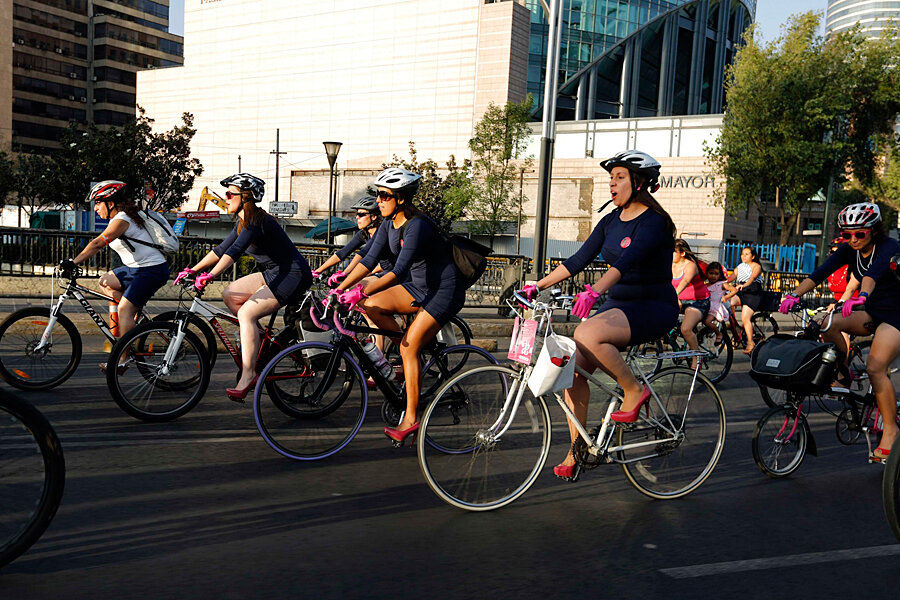Reporter's notebook: How has Mexico City changed?
Loading...
| Mexico City
Recently back in Mexico City for some reporting more than 12 years after I left my post as the Monitor's Latin America correspondent here, I had my eye out for what had changed – the good and the bad.
After a few days it struck me that most of the changes I was noticing were for the better.
One was the proliferation of bicycles. Just a decade ago bicycles were pretty much for little kids, a few Tour de France wannabes, or the poor. As a mode of transportation, bicycles were often used by modest local vendors: the gardener who pedaled over to cut our patch of grass every couple of weeks, or the knife sharpener who announced his arrival in the neighborhood by blowing on a whistle.
Now Mexico City is teeming with bicyclists. And it’s not just on Sundays, when the monument- and fountain-studded Paseo de la Reforma, a grand boulevard rivaling any in the world, is closed to automobile traffic. Reforma was lifeless on Sundays when I lived here, but now it's a day-long parade of joggers, people with their dogs, strollers (both the animate and inanimate varieties), and most of all, bikers.
At some point bicycles became utilitarian and chic for getting around the urban core here. It was stunning to see men in suits and young women in office work-clothes pedaling along at all times of day. Often the bikers were using the increasingly popular bike-share system, known as Ecobici.
Security and crime
Another positive change? The disappearance of crime from the top of people’s conversations. Granted, that’s not the same as saying crime has disappeared or that insecurity is no longer the national issue it was in the 1990s. It is. But crime does seem to have retreated. No longer do people in Mexico City talk about daily assaults and common “express kidnappings” – where victims are driven around town and forced to drain their bank accounts at gunpoint – like they did in my day.
There may be a dark side to this reduction of crime in the city's better neighborhoods. Crime has been pushed out to the surrounding, humble suburbs, some social experts here theorize.
It’s also true that insecurity is widespread and worse than a decade ago in some Mexican states, especially in poor rural areas, where kidnapping and extortion have skyrocketed.
Another theory is that the crime gangs are complicit in Mexico City's safer streets. The thought is that the criminals know – and this is true not just here but in other major cities around the world – that as long as they leave the image-conscious center of the metropolis alone, they are given more latitude to operate elsewhere.
A new, but familiar, sound
Another plus I discovered is that the air seems to be better. Maybe I just hit good days, but it seemed I could see the mountains surrounding the city more regularly than in the 1990s. When I lived here and ventured to take my bicycle out, people said it was a bad idea because of what was then Mexico City’s notoriously bad air.
Of course change does not have to be either good or bad for one to take note.
As I took a seat one evening at one of Mexico’s greatest culinary experiences, the stool-and-counter taqueria, or taco stand, I ended up coming face to face with the kind of change that is making the capital more of a global city than when I lived here.
As I happily munched on my tacos al pastor and alambre, I noticed that the two very local-looking young men on the stools next to me were speaking a lightly accented American English. This had me wondering: If they were Mexican, why were they speaking English to each other? And if they were American Hispanics, were they visiting family, or maybe studying here?
So I asked – and met Luis and Gary, both in fact Mexicans, but both 23-year-olds who had lived most of their lives in the United States. Now back in Mexico, they were on a dinner break from their job at an international call center down the street.
Luis had lived most of his life in Houston; Gary, in Grand Rapids. Their parents had taken them across the border to live when the young men were age 3 and 5 respectively. Now they take calls from Dish television customers in the US having trouble with their service. According to Luis, the building where they work has four floors of call centers for American companies like Best Buy and Time Warner Cable. Speaking American English is a selling point.
“I get people all the time saying, “Oh thank God you speak English,” Luis says. “Sometimes they ask where I am, and when I say Mexico City they say, 'Well you sound like you’re from here.'”
I tell them I used to live in Mexico City with my family and that we loved it here. I ask them how they like it, and they look at each other as if to mentally agree on their response. They say they’ve gotten used to it and it’s fine.
Leaving the taqueria, I walk down the street to check out the call center I’ve just learned about. There are no signs on the building, but I figure it must be the right one because several young women are seated out in front, also apparently on their dinner break. And they are all speaking English with a familiar accent.






